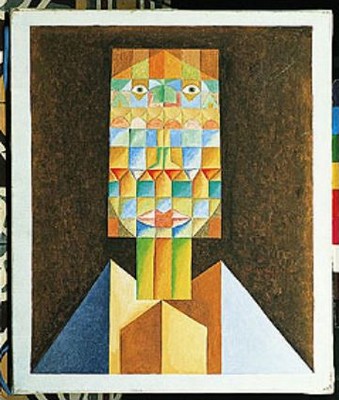Victor Brauner Centenary
Israel Museum, Jerusalem
January 1 - July 31 2004
The Alchemist, 1956
Oil on canvas
The Vera and Arturo Schwarz
Collection of Dada and Surrealist Art
Courtesy Israel Museum
VICTOR BRAUNER (1903-1966), a Romanian/French artist of Jewish origin, was an early adherent of the Surrealist movement who actively explored the realm of dreams and the unconscious, and thrived on the occult and the mystical. The content and style of his art reflect a fertile fusion of wide-ranging world cultures, mythologies, and religious beliefs, from Egyptian to Aztec, Native American to Oceanic, Jewish to Hindu. Victor Brauner’s works often have a naive, folk quality, realized in boldly colored abstract shapes and decorative patterning. While focusing primarily on figuration - whether human, animal or mythological - the works create an intricate lexicon of symbolic forms. Despite Brauner's eclectic progression of styles, his art speaks in a distinctive and coherent voice, propelled by a search for a universal spirit.
Born in the Carpathian Mountains of Romania, Victor Brauner was exposed to a range of folkloric traditions, attending the School of Fine Arts in Bucharest in 1921. A decade later Victor Brauner settled in Paris, where he was introduced to the Surrealists by Yves Tanguy, joining the group by 1933. Following the artist's first Parisian solo show at the Galerie Pierre in 1934, which was not well received, Victor Brauner left Paris, returning only in 1938. Several months later he lost his left eye while trying to break up a fight between Oscar Dominguez and Estaban Frances in Dominguez's studio. Prophetically, several years earlier, Brauner began painting works featuring human figures with mutilated eyes, including a self-portrait with a bleeding eye.
At the outbreak of World War II, unable to obtain suitable painting materials, Victor Brauner improvised with candle wax and developed the encaustic technique, incising and coloring the wax, favoring organic coloring materials such as coffee or walnut. This technique proved particularly apt for articulating his esoteric visions, as seen in Woman, Mountain, and The Object Gives Life, displayed in this special exhibit. Victor Brauner focused on developing his personal style, incorporating elements from Near Eastern art, such as the flattening and heraldic figures in Oppression of the Object, Kabbala, Biblical magic and alchemy, and other mystical texts, such as Novalis in The Object Gives Life.
Special exhibit curated by Adina Kamien-Kazhdan, Associate Curator, The Stella Fischbach Department of Modern Art.
THE ISRAEL MUSEUM, JERUSALEM

